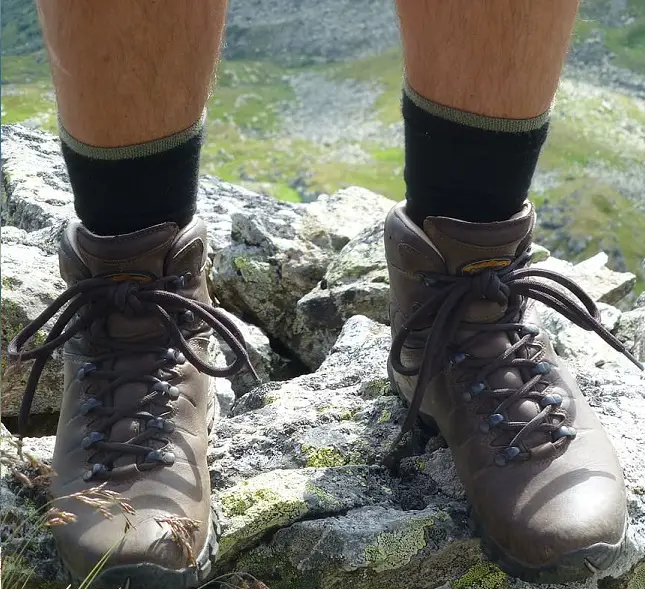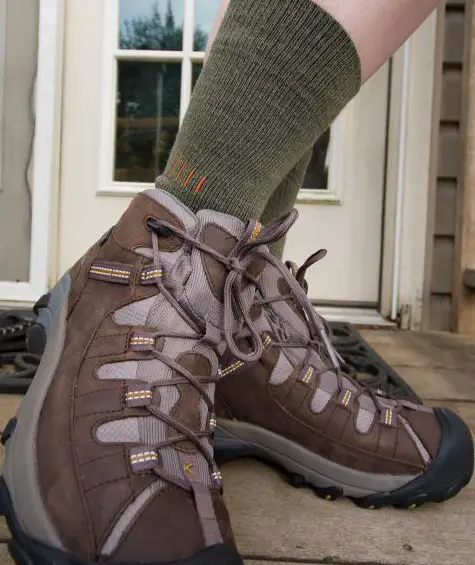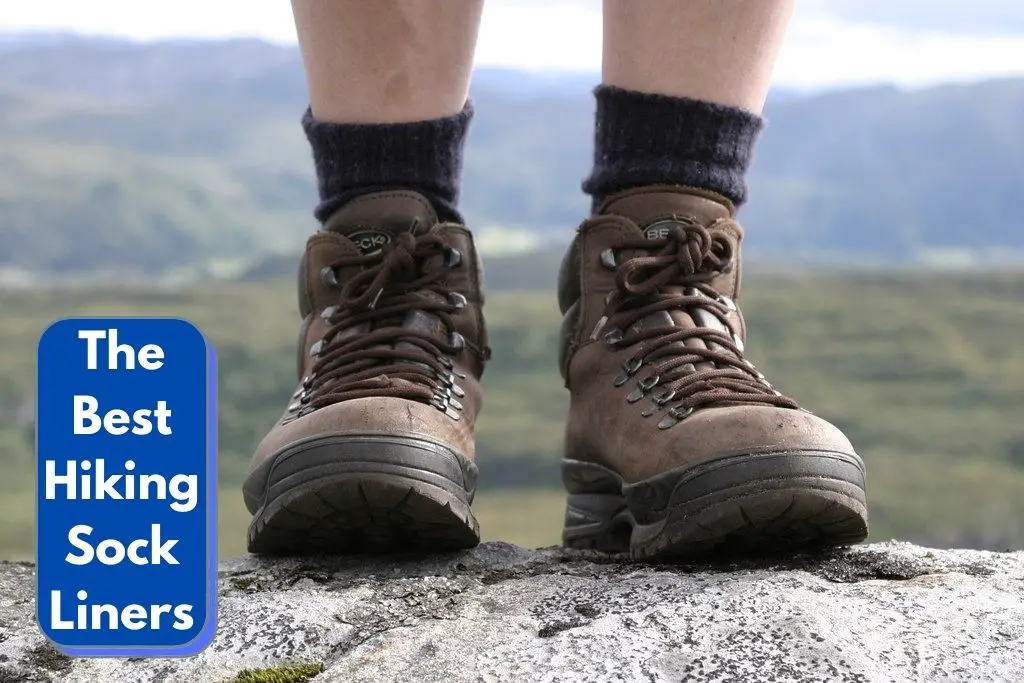If you’re an avid hiker, you’ve probably got an ever-growing wish list of hiking gear that you’re looking to add to your collection. We’re here to tell you that hiking sock liners should be at the top of your list! Studies show that wearing liner socks when hiking provides superior protection against blisters and adds comfort- and they’re quite affordable too.
We’ll go through the best liner socks for hiking along with why you should get a pair as soon as possible in this guide.
The 7 Best Liner Socks For Hiking
| Best 3-Season Hiking Toe Sock Liners | Injinji Liner Crew Toe Socks |
| Best Cold Weather Hiking Toe Sock Liners | Injinji Liner Crew NuWool Toe Socks |
| Best Wool Hiking Sock Liners | Smartwool Hiking Liner Socks |
| Best Coolmax Hiking Sock Liners | Fox River Wick Dry Coolmax Liner Socks |
| Best Cold Weather Hiking Sock Liners Runner-Up | Fox River Therm-A-Wick Liner Socks |
| Best Long Length Hiking Sock Liners | Fox River X-Static Liner Socks |
| Best Budget Hiking Sock Liners | Wigwam Coolmax Liner Socks |
Injinji Liner Crew Toe Socks

Materials: 75% Coolmax polyester, 21% Nylon, 4% Lycra
Injinji is well-known for their high quality toe sock liners, and these do a great job of combining the functionality of toe socks with the key features you need in a hiking liner sock.
These liners feature a blend of Coolmax, Nylon, and Lycra, and feature a mesh top design for extra ventilation.
Injinji Liner Crew NuWool Toe Socks

Materials: 41% NuWool, 41% Acrylic, 15% Nylon, 3% Lycra
Injinji is well-known for their high quality toe sock liners, and these do a great job of combining the functionality of toe socks with the key features you need in a hiking liner sock.
These liners feature a Injinji’s proprietary NuWool merino wool that provides excellent durability and prevents itching
Just like the regular Injinji liner crew toe socks, these liners feature a mesh top design for extra ventilation.
Smartwool Hiking Liner Socks

Materials: 59% Merino Wool, 39% Nylon, 2% Elastane
Smartwool’s liner socks provide warm insulation, a comfortable fit, and ultra light cushioning to give you the extra padding you need.
They’re made primarily of Merino wool and Nylon so they’re super soft and are machine washable.
Fox River Wick Dry Coolmax Liner Socks

Materials: 93% CoolMax polyester, 6% Nylon, 1% Spandex
Fox River’s Wick Dry Coolmax liners are excellent for keeping your feet cool by speeding up the evaporation of sweat.
The wick dry technology helps remove that moisture and prevent blisters and hot spots.
They’re also extremely comfortable and have low-profile seams – a huge plus.
Fox River Therm-A-Wick Liner Socks

Materials: 50% Polyester, 49% Nylon, 1% Spandex
Fox River’s Therm-A-Wick liner socks are the cool weather version of the Wick Dry Coolmax liners, so you’re getting the same great performance and moisture-wicking with added warmth for your feet on fall or winter hikes.
Fox River X-Static Liner Socks

Materials: 60% Polypropylene, 20% Nylon, 19% X-Static Nylon, 1% Spandex
The X-Static Liner socks rise higher than most socks to go over the calf, which provides much-needed length for those of us who use longer hiking socks for our outer layer.
These socks neutralize foot odor thanks to the silver-bonded nylon fibers, and there’s a smooth, flat toe seam to make sure you don’t even know these socks are there.
Wigwam Coolmax Liner Socks

Materials: 62% Coolmax Polyester, 37% Nylon, 1% Spandex
Wigwam’s Coolmax liner socks are affordable and no-frills, with the Coolmax doing it’s job to keep your feet dry and comfy while you hike.
They’re also a little longer than some of the other best hiking sock liners we’ve reviewed, making them a better fit for more of your outer hiking socks.
What Are Sock Liners?
Sock liners are a breathable, thin sock that you wear underneath your regular hiking socks.
They’re usually made of moisture-wicking and breathable fabrics like silk, nylon, polyester, or wool.
Benefits Of Using Liner Socks For Hiking
You should absolutely wear liner socks when hiking thanks to the following key benefits they provide over wearing only hiking socks on their own:
Reduce Friction, Hot Spots, & Blisters
Every hiking boot and hiking shoe rubs your feet, and those friction points create hot spots, which are places where painful blisters will eventually form.
Using a sock liner for hiking will reduce this friction and prevent blisters more effectively than just using hiking socks.
Sock Liners Are Moisture-Wicking
When you’re wearing thick hiking socks inside thick, rugged hiking boots, that warm environment can cause your feet to sweat.
Sweat softens your skin, making it more susceptible to hot spots and blisters.
Sock liners are like a base layer for your feet and help to move the sweat and moisture away from your skin and into your thicker outer sock, keeping your feet dry and blister-free.
Added Warmth
Using sock liners when hiking adds an extra thermal layer to help keep your feet warm during hikes in cold weather.
Improved Comfort & Cushioning
Although liner socks are thin, the material is very comfortable, and even a millimeter or two of extra fabric can provide extra cushioning that you’ll reap the benefits of over long hikes.

Hiking Liner Socks Or Not? Are They Necessary?
If you’re going on a short hike with some good hiking boots that have been properly broken in, you are fine going without liners.
If you’re going on a several-day hike, thru-hiking, or will be hiking in cold weather, we definitely recommend wearing hiking sock liners.
They are lightweight and compact, so you should throw a pair in your hiking fanny pack or day pack in case you need them as added protection.
Different Ways To Use Liner Socks For Hiking
Use Your Liners As A Base Layer
This is the most common way hikers wear liner socks, as the liner will pull moisture away from your skin and move it to your thicker outer sock layer.
Wear Liner Socks Standalone
If you have tight-fitting hiking boots or shoes, or just want to keep your feet cooler on those really hot summer hikes, wearing liner socks on their own is a great way to keep your feet cool.
You’ll still get the moisture-wicking benefits of your sock liners this way, so your feet will keep dry.
If you’re dealing with tight boots, check out our guide on how to stretch out hiking boots for some tips to try.
Try Out Toe Sock Liners For Hiking
Toe socks separate your toes for reduced friction along with all the existing benefits of liner socks.
Most people who try out toe sock liners never go back for a reason!

How To Pick The Best Hiking Sock Liners
If you choose the best hiking sock liners, you’ll never know they’re there.
Consider the following aspects when making your selection:
Materials
Sock liners are made from different materials that each have their own properties:
- Coolmax is a polyester blend that dries quickly and doesn’t absorb much moisture.
- Merino Wool is warmer but takes a little longer to dry.
- Polypropylene is a synthetic fiber available in different thicknesses for hiking in different seasons.
- Silk sock liners for hiking are commonly blended with nylon or spandex to give them better moisture-wicking and durability.
- Nylon, Polyester, and Spandex are inexpensive synthetic materials that are good at drying quickly and are moisture-wicking.
Thickness
The main consideration of choosing your liner sock’s thickness should be what season(s) you’ll mostly be hiking in.
If you’ll be skipping liner socks during your spring and summer hikes, then opt for a thicker liner that will add warmth during fall and winter hiking.
Although nearly all liner socks are quite thin, consider if your hiking boots are extremely tight and consider choosing the thinnest liner socks available.
Length
Make sure to choose hiking liners that are longer than your regular hiking socks.
Choosing liner socks that are too short will be annoying because you can’t adjust them as easily, and they may bunch up with your outer socks and ride down your leg as you hike.
Comfort
Avoid liner socks with bumps, patterns, or thick seams on them which will cause friction and irritate your feet.
Durability
All the best liner socks for hiking have high durability, but if you’re choosing something off this list, be sure and take a look at the reviews from actual users to ensure that your liner socks won’t give out on you after a few hikes.
Design
Liner socks for hiking come in many different patterns and colors.
While this may be obvious, be sure to choose a pair with a color or design that you’re going to like wearing and that suits your personal taste.
Other Ways To Prevent Blisters While Hiking
Sock liners are one of many options for cutting down on the possibility of blisters while you’re hiking.
Take a look at our guide on how to prepare your feet for hiking for some great tips.
In addition, you can use the following options:
- Neoprene hiking socks
- Tape like Moleskin, Rock Tape or Leukotape
- Spraying your feet with antiperspirant
- Blister prevention patches
- Lubricating your feet with Vaseline or HikeGoo
Hiking Sock Liners Frequently Asked Questions
We definitely recommend wearing sock liners when hiking due to the added comfort, moisture-wicking, and protection against blisters and hot spots.
Liner socks are thin socks that you can wear as a base layer beneath your regular hiking socks or as standalone socks that offer better protection against sweat and blisters.
You don’t need to have sock liners to go hiking, but we recommend them due to all their benefits.
Sock liners are great for hiking, and you should absolutely give them a try – they’re affordable, lightweight, and can fit in your pack easily.
There’s no rule saying that you must wear sock liners while hiking, but it’ll make the experience much more pleasurable.

